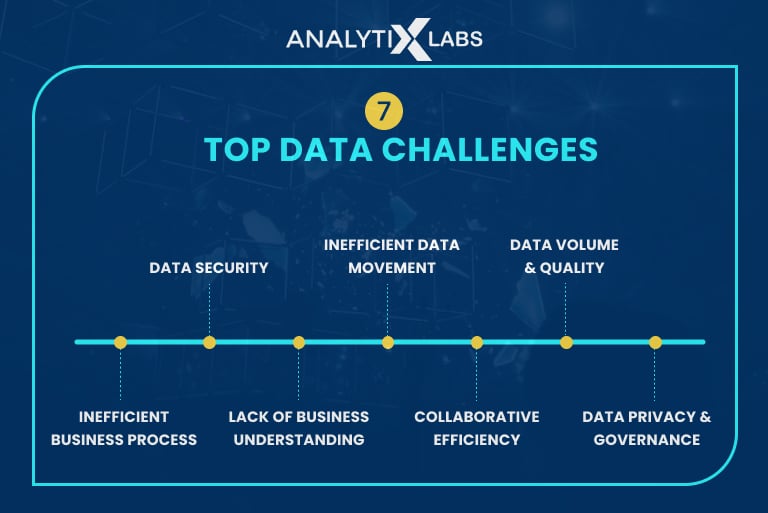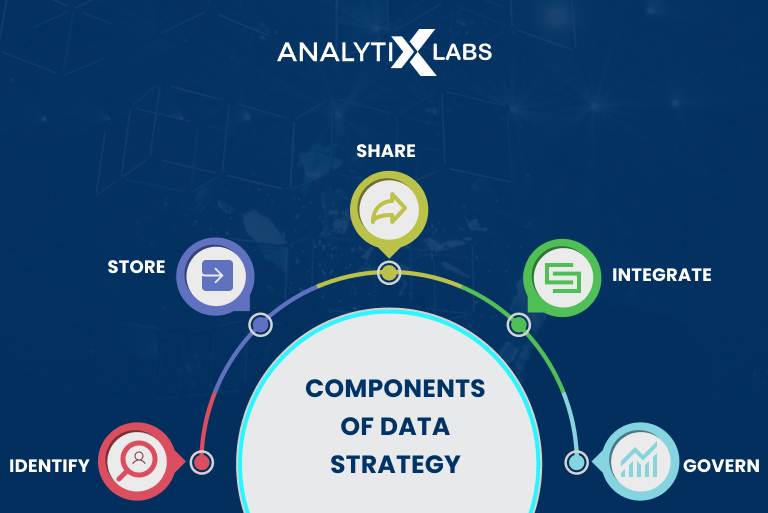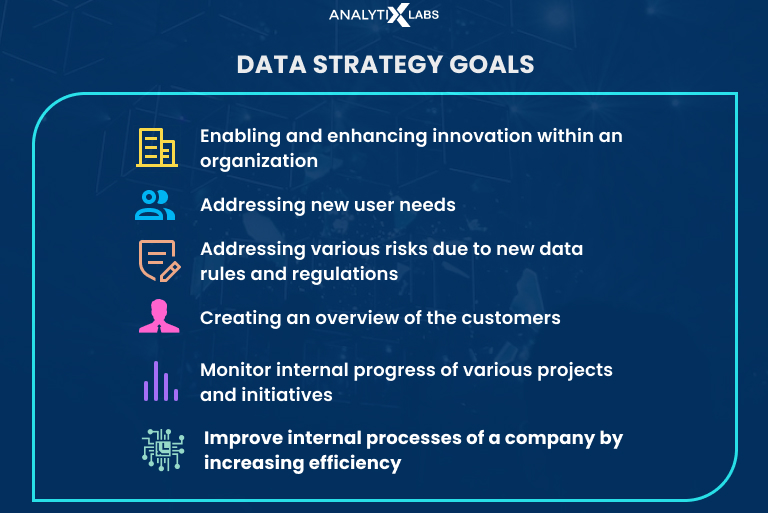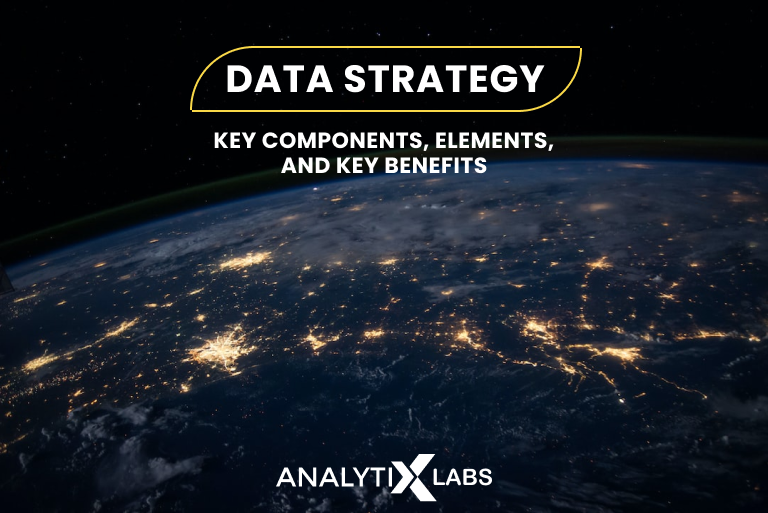The evolving landscape of data science and analytics highlights the growing significance of data, accompanied by challenges in effective management. Simply possessing quality data is insufficient; businesses need to address the importance of efficient data handling, and that’s where data strategy plays a crucial role.
Data strategy refers to the combinations of various tools, rules, and processes that help define, manage, and analyze data. With the help of data strategy, business intelligence can be maintained, enabling companies to do efficient business.
According to Gartner, 87% of companies face low maturity in business intelligence and analytics, resulting in a mere 17% deployment of business solutions.
In this article, you will learn about data strategy, its importance, and other information, such as the challenges organizations face when dealing with data, significant elements, ways to improve it, etc.
Let’s first start with understanding the common challenges companies face today when dealing with data. This will help you better understand what data strategy is all about and the role it plays in companies.
Download the Data Science Bible – The Ultimate Guide to Becoming a Data Scientist
Top 7 Data Challenges
There is a common saying – Necessity is the mother of all inventions. To understand data strategy, it’s essential first to understand the challenges that led to its invention.

1. Inefficient business process
Businesses often suffer from the issue of slow and inefficient standard operating procedures that lead to numerous problems. Therefore, companies need an excellent data-driven strategy to constantly update their procedures to adapt to the changing environment.
2. Data Privacy & Governance
Data privacy is a significant issue today. While companies want to have as much user data as possible, protecting the rights is also essential. Companies can land in legal trouble if they fail to protect the rights of their customer and use private data without their consent. The laws regarding the use of data are also becoming stringent and complex, and business needs to ensure that they don’t violate them.
3. Data Security
Cybercrime and data thefts are on the rise, and so is the need for data. Given the demand and supply dynamics, data is now considered the new oil. Unsurprisingly, many are trying to steal and sell this data to organizations and countries.
This is detrimental to individuals and, in some cases, can even be dangerous to national security. Companies, therefore, need to establish protocols to improve technology to ensure that gathering and dealing with data is secure and leakproof.
4. Lack of Business Understanding
Businesses today are complex, with several departments using numerous tools and tackling various problems. Also, companies must handle supply chain issues and increasing competition in the globalized world. All this complexity leads to gaps in the understanding of the individuals working in these companies regarding various business needs and goals. A good data and analytics strategy can help here.
5. Inefficient Data Movement
An extension to the abovementioned issues is the problem of moving data within the business organization. As different departments generate data in their data silos, sharing data with other departments can become a significant issue. This inefficient data movement leads to problems such as duplication, non-standardization, etc.
6. Collaborative Efficiency
Traditionally data has been considered the by-product of various processes and projects, leading to organizations becoming more inefficient, causing a drop in data quality. Today, there is an increasing need to collect data actively.
However, data requirements often overlap between departments, and departments do not need to look for data from scratch. Often, the data is available within the organization, which can reduce the overlapping of costs and efforts. Thus, a data strategy framework is required.
7. Data Volume & Quality
The surge in data generation, driven by IoT, rapid digitization, social media, improved computer hardware, and faster internet, necessitates businesses to formulate effective strategies. Mishandled data can lead to complications, potentially transforming data from an asset into a liability for organizations.
The sheer amount of data available has led to increasing data veracity. With vast amounts of data comes tremendous information.
However, companies must still identify the relevant piece from the vast data. This can become an issue in companies with prevalent non-standardization, inaccessibility, and poor data management.
Given the many challenges a good strategy has to resolve, let’s now understand the data strategy, its main components, and its primary goals.
What is Data Strategy?
Data strategy refers to the numerous plans, processes, and rules to manage the data available to a company. It is vital to companies as it allows them to improve data acquisition, better manage and secure their data, and maximize data-backed decision-making.
There are numerous components to a data strategy. To frame the strategy, one needs to understand these fundamental building blocks.
In the past, companies used to focus mainly on the storage aspect of data. Handling data retention used to be the prime component of a data strategy and various sophisticated methods were developed for the same.
However, the core components of data strategy include developing methodologies to store, acquire, manage, share, and use data.
Let’s discuss all these components one by one.
Components of a Data Strategy

1. Identify
A data strategy’s first and essential component is finding the means to identify, acquire, and represent data. The immediate aim of a company is to store and process data; however, this is difficult to do until and unless the data is appropriately defined.
Defining data here means that the data should have value name and representation, defined format, consistent naming conventions, etc.
Developing a data catalog is also an essential aspect of this component. Here, metadata plays a vital role as it helps define the data in terms of its origin, location, domain values, etc.
2. Store
As mentioned earlier, data storage is a crucial element of a data strategy. Despite its fundamental nature, mastering data storage requires organizational discipline.
The evolution of the data strategy concept emphasizes efficient storage, moving beyond the creation of systems to enable easy sharing and movement of data between systems.
Big data has transformed data science, fostering information sharing within and between companies. The shared data, categorized as internal and external, encompasses customer and purchase details and third-party and cloud application data.
Without centralized management, this can result in data duplication, as each system independently manages space, leading to redundant copies.
The instinctive solution is consolidating all data in one place, which poses challenges. Centralized storage is impractical due to the need for data sharing across various systems, especially for large and distributed companies.
A practical strategy involves facilitating easy access for individuals or departments to locate and retrieve specific data, recognizing that not everyone requires access to company-wide data.
3. Share
Back in the day, data sharing used to be infrequent. When there used to be a request for data, an application developer typically used to create an extract of it. Most companies didn’t provide a budget or allocate staff resources to perform this nontransactional data sharing.
This data sharing was eventually addressed as a personal favor between colleagues. Also, most application systems were not designed to keep frequent data sharing in mind.
Today, the scenario is different, with data sharing being a business need, and business success depends on how well the data can be shared. Thus, an essential component of a good data strategy is good data storage and reasonable provisions for data sharing.
4. Integrate
A good strategy refers to the ease of data sharing and how the data is packaged, which is crucial as organizations deal with numerous systems today. Integrating various data sources is the most challenging and costly data strategy component.
Integration extends beyond the ETL process and data movement between systems; it encompasses unifying data across multiple sources without relying on unique identifiers or explicit keys.
As mentioned earlier, organizational departments often operate in silos, lacking awareness of how others consume data. Each department or project creates its own logic to link values across common data sources.
However, this decentralized approach poses challenges, especially as data volume and sources increase. Consistently integrating data across various projects becomes less probable. Therefore, integration is a fundamental component of a robust data strategy.
5. Govern
How the data is processed, shared, and manipulated refers to the last component of data strategy – governance. Data governance refers to the idea that proper guidelines should be laid out to ensure that data integrity is not lost when shared and used by various entities.
It includes establishing security details, naming standards, data rules, correcting data logic, etc. A data strategy with a good governance component can help increase data accuracy, establish better terminology standards, etc.
Thus, developing information policies and rules for uniform usage, manipulation, and data management is a must.
Thus, all these components help in achieving various goals of a data strategy, such as:

- Enabling and enhancing innovation within an organization
- Addressing new user needs
- Addressing various risks due to new data rules and regulations
- Creating an overview of the customers
- Monitor internal progress of various projects and initiatives
- Future predictions of market trends and customer needs
- Improve internal processes of a company by increasing efficiency
As you can now understand, data strategy is a complex topic with multiple components and goals. While the discussed components highlight the importance of data strategy, one needs to get into specifics.
In the next section, you will learn how data strategy is crucial for any organization.
Why do businesses need data strategy?
The use of data in companies is ever-growing, and as discussed, it is crucial to develop a set of rules and a roadmap to manage this data. A good data strategy is vital for a company to understand its customer base and enable effective decision-making to promote growth and keep its competitive edge. The following are the seven most important reasons organizations must focus on data strategy.

1. Ensure data security
An effective data strategy facilitates various data defense activities, enabling companies to protect themselves and their customers by detecting and limiting fraud and ensuring compliance with data privacy regulations.
It also enhances the integrity of financial reports and establishes a system to prevent data theft. The strategy is crucial for intelligently using data by safeguarding it from internal redundancies and unauthorized usage.
Moreover, a robust data strategy is essential for minimizing breaches and mitigating risks, especially as companies handle highly sensitive data. Mismanagement of this data can lead to financial loss and damage to reputation. Modern data strategies incorporate diverse data protection methodologies, including advanced surveillance methods.
2. Better decision making
More and more companies are placing their future growth in data-based decision-making. As data can hold a lot of information, companies employ CDOs (Chief Data Officers) who manage and prepare data to expand data-driven decisions at every level of the organization.
Despite the abundance of data, executing this vision is challenging. Many experts assert that the crux of the issue lies in the lack of an effective data strategy. A well-crafted data strategy enables organizations to refine their data, facilitating innovation and value creation while aligning with current and future market trends.
An impractical data strategy can lead to inaccurate decision-making, irrespective of the volume and veracity of data. In short, data strategy plays a crucial role in supporting better data management and analytics, which is required to make data-backed informed decisions to help a company’s financial performance.
Also read: Important Applications of Data Analytics
3. New business opportunities
Data can be utilized to identify new business opportunities. For example, by identifying that an area has more elderly or disabled persons, healthcare-related companies can focus more on that area and look for business opportunities.
Companies need to have properly labeled data to perform this effective data analysis, which can be done by implementing better data collection and maintenance strategies.
A good data strategy can allow companies to have customer’s complete data, including their demographics and other details such as gender, age, occupation, income level, etc.
Such data can be made possible due to a data strategy that allows analysts to perform customer segmentation and, as indicated earlier, can enable companies to look for new business opportunities.
4. Improved efficiency
As mentioned earlier, a central element of a data strategy is integration, facilitating a seamless flow of data within an organization.
Effective collaboration among departments can address supply chain issues, and the smooth transfer of information between them enables swift decision-making. Information gaps can give rise to various issues.
For example, if the sales team can use their data to project near-term growth and demand, then this information can be shared with the other units in the supply chain so that proper plans can be created.
The benefits of a good data strategy can manifest in multiple ways, such as better stock control through automatic replenishing of stock, anticipating service usage, delivery route optimization, automation of repetitive tasks, etc.
5. Early identification of customer trends
Customer satisfaction is among the top most priority for any company. A good data strategy allows companies to prepare their data in such a way that they can anticipate what customer needs will be in the future.
This can help companies create long-term strategies by allocating appropriate funds for the R&D of the anticipated product or technology.
Data strategy also benefits companies like Amazon or Netflix, which can use good quality data to recommend products/films based on your previous preferences.
6. Addressing regulation requirements
The use of customer data by companies is a sensitive issue today. Governments are constantly developing new rules and regulations to ensure that companies are not using customer data in an unethical way and infringing upon their right to privacy.
Companies, therefore, need to have a robust data strategy as it allows them to stay compliant with the regulatory authorities. A good data strategy can ensure that the company manages the data so that the customer’s privacy, security, and integrity are always maintained.
7. Increased monetization
Data strategy can also help companies to maximize monetization. Data-driven products and services can help companies enhance profitability and expand their revenue streams.
For example, Facebook uses data to drive its advertising offering. Various companies use this user data to develop data-driven products that they can monetize.
Now, while we have discussed the several components of data strategy and their consequent benefits, there is still more to know about it, as it has numerous elements you must keep in mind when designing your data strategy.
You can enroll in our Data Science certification course and our exclusive PG in Data Science course at your convenience or book a demo with us.
What are the elements of a data strategy?
Suppose you’re about to outline your data strategy; it should encompass key elements such as identity, storage, sharing, integration, and governance.
However, to put a data strategy into place using the discussed components, you must ensure that the strategy has some key elements to ensure its success. Hence, seven elements are discussed next to help you or your organization build a great data strategy.
-
Business strategy
An essential element of any data strategy is a clear business strategy. It would be best to clearly understand your business objectives, as only then can you have a data strategy that aligns with them. A business strategy helps explain the business problems and challenges and how a data strategy can address them.
Therefore, a business strategy will include stating deliverables, identifying core competencies, stating the data insights requirements to measure progress, stay competitive and innovative, and how the data strategy can provide you with those insights.
Also read: Future of Business Analytics – Unlocking data-driven insights for success
-
Data sourcing
The next element in a data strategy is data sourcing. It is crucial to understand various data requirements in terms of-
- Data Structure: What kind of data are you looking for? Is it structured, semi-structured, or unstructured? Understand the data structures and their types.
- Nature of Analysis: What kind of data model are you going for? Is it predictive, forecasting, segmentation, statistical, machine learning, deep learning, etc.?
- Type of Sources: What are going to be your data sources? Are they going to be in-house or external?
All the above questions must be answered before proceeding to the next aspect of a data strategy.
Also read: Importance of Machine Learning
-
Infrastructure building
The answers to the above questions will help you get your tools and correct infrastructure in place. Let’s take a straightforward example. Suppose you plan to deal with structured data. In that case, you will probably focus on data warehouses that will allow for the faster query of data.
If you expect to deal with multiple data types, you need to go for a combination of data storage techniques that will be required to transform and use such data. Thus, different tools and techniques must be operated based on the data strategy demands. Efficiency is also a big aspect here, as specific tools can provide the most efficient way to execute a data strategy.
-
Data insights
This element of data strategy deals with how you plan to manifest the insights you have gained from the data. You need to present the insights through visualization tools so that the analytics allow for easy diagnosis of problems. The data insight must be what you aim for, and the expectations must be clearly defined beforehand.
-
Skills and capacity building
While describing the data strategy, you must consider the resources needed to execute the strategy. It’s not about the infrastructure and tools, as discussed before, but the human resources must also be considered.
Organizations need the right individuals with the required skill sets to execute a data strategy. The leadership also needs to be designed so that positions like CDOs (Chief Data Officers) are there and are well-connected with the heads of other departments.
-
Data management
A fundamental aspect of a data strategy is data management, encompassing guidelines for data sharing, manipulation, and adaptation. Considering external factors like new tools, techniques, laws, and cyber threats that can impact data management capabilities is crucial.
In designing a data strategy, a crucial decision is the chosen approach. A data defense approach focuses on compliance with regulations, fraud detection, and theft prevention.
On the other hand, a data offense approach enhances agility and flexibility in centrally governed data management systems to trace information back to a single source of truth. The challenge lies in finding the right balance and the optimal position on the data offense-defense spectrum.
-
Roadmap
Lastly, a key element of a data strategy is a clear action plan explaining all the above elements and how the organization plans to implement them. Part of the roadmap should also be the timeline and the scope of work for the individuals responsible for executing the data strategy. It should also be practical and flexible regarding its timelines and goals.
The above seven elements are crucial to any data strategy; however, many issues can hinder its effectiveness once implemented. Next, you will explore the various ways in which a data strategy can be improved.
Tips to Improve Data Insight Strategy
Data strategy is not a rigid thing and needs to be dynamic. There are multiple ways through which it can stay relevant and can increase its effectiveness.
- Centralize and Integrate Data : If multiple systems exist, you must curtail and make them centralized while ensuring appropriate access to different stakeholders.
- Tracking : Avoid information overload and update what you are trying to find from the data.
- Define End Objective : As more challenges arise, the end objective from analytics can evolve; therefore, you need to modify your data strategy based on your new objectives.
- Improve Continuously : New scenarios can arise regarding the nature of available data or regulatory frameworks requiring you to continuously improve and modify your data strategy.
- Improve IT : Implementing a data strategy is costly. While you may use all the latest tools and techniques available when implementing a data strategy, you must keep improving the infrastructure and plug any gaps by implementing better technology.
- Culture Change : The best way to improve data strategy is to familiarize it with the various individuals in the organization. This helps improve the data management discipline and increases data usage ethics over time.
- Evolve Roadmap : Lastly, you must constantly redesign your original roadmap when you first started designing and implementing the data strategy as the world around you keeps evolving.
Conclusion
Data Strategy is the user manual through which an organization plans to deal with the data at its disposal. As the complexity and volume of data increase, the need for an effective data strategy is rising. The biggest reason any organization fails is an ineffective use of data that stems from a flawed data strategy. Thus, one needs to invest more time and resources in it.
FAQs:
- What does data insight mean?
Data insights mean information gained from data that can help businesses make better decisions.
- How do you make data insight?
One can gain data insight by performing analytics on data through statistical modeling and other techniques such as machine learning, deep learning, etc.
- What are the four big data strategies?
The four big data strategies include performance management, data exploration, social analytics, and decision science.
I hope this article helped to expand your understanding of data strategy. If you have more questions or want to learn more about data strategy and data science, please write back to us.




![Tree Traversal in Data Structure Using Python [with Codes] tree traversal in data structure](https://www.analytixlabs.co.in/blog/wp-content/uploads/2025/01/Cover-Image-1-370x245.jpg)



